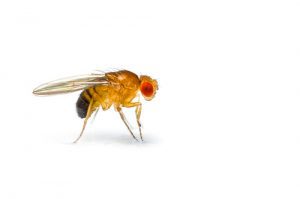Finding the Source of Fruit Flies
By Chris Williams on May 3, 2011.
Q. My kitchen has been invaded by tiny little gnats. My sister says they’re fruit flies. We also have them in the garage but I can’t figure out where they’re coming from. We keep a cardboard box of picked pears from our fruit trees in there and they seem to be interested in that. Any help?
A. Your sister is probably right in identifying the gnats as fruit flies. The common fruit fly has many other names. It’s also called the drosophila fly, pomace fly, or vinegar fly. [To see what a fruit fly looks like up close, look in our Pest Library under Flies.] To most people, it’s just another obnoxious gnat. But tiny fruit flies are especially trying because they are attracted to our food and drink.

Fruit flies are usually the little gnats that you find hovering around your fruit bowl or drowning in your beer. That’s because they are attracted to yeasty, vinegary odors for egg laying. The white, legless larvae feed and develop in moist or semi-liquid fermenting foods. Look for a site with food ooze, goo, gunk, crud, or scum and you’ll likely find the source of your fruit flies!
In a typical home, there can be many varied breeding sites for fruit flies. Unfortunately, if you don’t find them all, you won’t get rid of the fly problem. Fruit flies can complete development in only 8 days so even temporary sites like a rotting tomato can be a source for the flies. If your fruit fly infestation didn’t start with the pears, the flies have almost certainly moved into the pears and maybe into other sites as well. Here are some of the most common sources of fruit flies in and around a home:
 (1) Over-ripe or fermenting fruits and vegetables – Check vegetable storage bins and fruit bowls for fruits or vegetables that are too soft or rotting. Discard produce as soon as it starts to “go bad.” Sometimes when you bring fresh fruit into your home from the garden or a farmers’ market, it is already infested with fruit fly larvae. Also look for spillage of food or liquid that may have fallen behind an appliance or into another unseen area and been overlooked. Pick up rotting fruits or vegetables in your yard that could be breeding fruit flies which can then find their way inside.
(1) Over-ripe or fermenting fruits and vegetables – Check vegetable storage bins and fruit bowls for fruits or vegetables that are too soft or rotting. Discard produce as soon as it starts to “go bad.” Sometimes when you bring fresh fruit into your home from the garden or a farmers’ market, it is already infested with fruit fly larvae. Also look for spillage of food or liquid that may have fallen behind an appliance or into another unseen area and been overlooked. Pick up rotting fruits or vegetables in your yard that could be breeding fruit flies which can then find their way inside.
(2) Certain beverages – Beer, wine, cider, juice, and vinegar are all attractive to fruit flies because they give off a yeasty, fermenting odor. Look for unsealed containers, overlooked spillage, or discarded bottles with residue remaining. If you have a beer or wine dispenser, check that, too.
(3) Garbage cans and recycling bins – Wash out containers regularly, otherwise a semi-liquid goo can accumulate in the bottom. Look underneath plastic trash can liners. Rinse out food and drink containers before placing them in recycling bins. Fruit flies can even breed in the residue left in a ketchup bottle, pickle jar, or a soft drink can in a recycling bin.
(4) Drip pans – Check drip pans underneath refrigerators, air conditioners, or hot water heaters. Clean and empty them often.
(5) Miscellaneous other sources – Scummy wash water left in mop buckets or slop sinks; old, soured mops or rags; dirty trash compactors or disposals; home canning equipment; compost piles; slimy potted plant saucers; stagnant drain traps; and sometimes animal feces.
If you’re overwhelmed with fruit flies or other tiny gnats and need help, give Colonial a call.